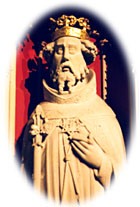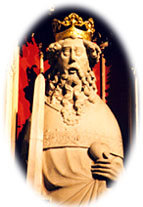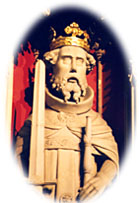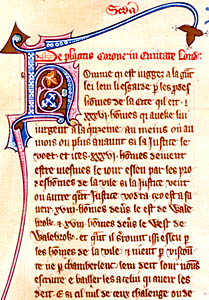Keywords: medieval urban government constitution laws charters liberties customs custumals


| CONSTITUTION | ||
Keywords: medieval urban government constitution laws charters liberties customs custumals
It is not clear whether, before the twelfth century, towns had any officially recognized powers relating to communal self-government, or any special privileges that definitively distinguished the personal status of their inhabitants from those of non-urban areas, with the possible exceptions of holding property in exchange for money rents rather than personal services, and (less certainly) in exemptions from paying tolls on merchandize. However, there was certainly some differentiation of town and countryside within the national administrative system.
The folkmoot must have provided a mechanism for the discussion of local concerns in a way that allowed for expression of aspirations and ambitions. Merchant gilds, where they existed, likely provided another and perhaps more important focus for such discussions, and even for the momentum behind the acquisition of royal charters, since they may already have been instrumental in the local regulation of commercial affairs, and since their members were those townspeople with the most to gain; this would help explain why such gilds were among the earlier privileges to be confirmed by charter. Later, attention turned more to building up the jurisdiction of the town court, where it was under the presidency of officers elected by the community, and/or to establishing mayors and councils as administrative authorities with no direct accountability to higher powers.
Certain aspects of urban administration, society and economic affairs were influenced by local customs, which varied from place to place. But the character, origin and antiquity of such customs is difficult to judge in the absence of written records; royal charters make reference to their existence, but without (in most cases) specifically indicating what they were. Only so much can be gleaned on this subject from the Domesday Book, which gives our best single view of towns prior to the appearance of royal bureaucratic records series in the twelfth century.
That century too is hardly rich in written records relevant to urban history. There are a few documents in the form of royal charter grants to a handful of towns – not all of them accepted unquestioningly by historians as authentic – and the Exchequer Pipe Rolls (recording information about the farm and other payments made from the towns). But, other than some private charters related to real estate transactions, no documents directly from the towns themselves until the very end of the century. It does not appear, and we should not be too surprised at the fact, that any effort was made to record local customs until local self-government – and perhaps more than local government, local bureaucracy – started to take shape as the thirteenth century progressed. By which time we cannot be certain to what extent the formulated customs reflect earlier practice.
The consequence of this paucity of documentation is that, while we are able to reconstruct with some confidence the broad framework of the development of the urban constitution in its early period, we have little direct evidence of the thinking behind that course of development. The account of the setting up of administrative mechanisms at Ipswich in 1200 – itself prompted by the grant of a royal charter – is a rare and thereby important window onto urban affairs even though, since known only from a later copies, not entirely free of suspicion. Consequently, historians must rely heavily on hypothesis to piece together the fragmentary evidence.
One of the fundamental sources of evidence about the borough constitution are royal charters granting liberties (the term franchises being more commonly used today): privileges related principally to aspects of self-government, i.e. independence from other administrative systems or jurisdictions, and special rights that gave consideration to the particular character and needs of an urban community. The grants were made usually in return for a lump-sum payment and agreement by the representatives of the local community to make a yearly payment – the fee farm – to compensate the king for revenues he would be giving up by turning over administration powers to the borough, e.g. market tolls. Paralleling the charters of liberties granted by the king were similar grants made by lesser lords – known as "mesne lords" because they stood as intermediaries in lordship between the king and his subjects – to boroughs they controlled. Typically these lords, or the burgesses themselves, would seek confirmation from the king of such grants.
 |
 |
|
The earliest charters of liberties were granted
by Henry I (upper
left) and Henry II
(upper right),
cautiously allowing towns some responsibility for their own affairs.
Richard I (lower
left) and John
(lower right),
in need of money, were more liberal in selling towns the privileges they
sought. Late 15th century statuary from the choir screen in York Minster. Photos © S. Alsford |
|
 |
 |
Early students of English urban history relied heavily on these charters as indicators of the scope of self-government and as causes of urban growth. Today, historians place much less emphasis on such documents, no longer considering them the principal instruments defining urban status, although this is perhaps partly a reaction against the over-emphasis given by earlier generations. While the formal concessions of privileges by the king, or other lord of the borough, were valuable tools in the process of urban development, they were not indispensable, and in some ways were more markers of a stage in that development, consolidating powers which had sometimes been informally exercised (or usurped) prior to their official recognition in the charters. One example is the privilege known as "return of writs", whereby the county sheriff could not personally carry out royal directives that applied to towns, but had to pass the written commands along to the town officials, who then had to make a written return confirming that they had fulfilled the instructions. Some historians made much of this supposed advance in freedom, and it is true that there were a flurry of such grants in the mid-1250s, although that owes something to Henry III's need, in view of the growing baronial opposition, to curry favour with his towns. However, it is now known that this procedure was in practice prior to the charter grants. In that light the grants appear more to formalize an existing situation, or even to control its applicability via definition. The Quo Warranto enquiries begun in the late thirteenth century to investigate the franchises claimed by local landlords and authorities gave additional motivation to towns to have their claims recognized via royal charters; apart from the instance mentioned above, the charters of Henry III and Edward I in fact did not extend much beyond acknowledging the powers and privileges granted by their predecessors.
The initiative for charters, whether they confirmed existing rights or granted new ones, came largely from the towns themselves; the gains made by some towns, notably London, appear to have stimulated copycat efforts by others. While much of what they permitted was in the interest of the development of local government within the broader framework of a national system of government answerable to the monarchy, England's kings were anxious to avoid stimulating the level of autonomy found in some places in continental Europe. Charter terms, if not their wording, were most probably – particularly in the later period – drafted by town representatives, or at least reflected what the townsmen asked for in written petitions (few of which have survived); although we should envisage charters as a product of negotiation between local and central governments, so that the end-result served the interests of both. But because the final text of the charters was drawn up by clerks of the central government, which had an interest both in controlling the extent of urban independence and in ensuring some consistency in the powers accorded to the different boroughs, and because of a strong tendency to use charters granted to the earlier recipients as models for those granted to later recipients, historians have to beware of taking the precise wording at face value.
Nonetheless, the earliest royal charters to towns are important sources of evidence simply because of the paucity of documentation produced by, or surviving from, the towns themselves, especially prior to the fourteenth century. Many of the later charters were little more than reiterations of the earlier, sometimes with a few additions, largely because towns felt it advisable to purchase inspections and confirmations of their privileges from each new king coming to the throne. Only in this way could towns perpetuate their rights before formal incorporation – and even after incorporation made renewal unnecessary, attachment to tradition prompted towns to continue to seek royal confirmations. Royal charters were, in essence, the legal warrant or mandate by the country's highest authority for the existence of borough government and for the scope of its authority (prior to the regularization of borough powers through the Municipal Corporations Act of 1835). These charters were usually issued under the great seal. However, grants of minor privileges or mere confirmations of charters came increasingly to be issued as letters patent.
The charters are perhaps most useful for giving us an overview of the stages in evolution of the borough constitution, and of the growing ambitions of the borough community to assert control of its internal affairs and eliminate the interference of "foreign" authorities, such as shire officials or other officers of the royal administration. As a generalization, we can say that the early charters, of twelfth and thirteenth centuries, acted to differentiate town and countryside in terms of distinctive rights (particularly tenurial rights), to establish the basic mechanisms for administration (e.g. court, officers, merchant gild), to begin the process of making those mechanisms semi-independent of external authorities, and to foster the centralization of commerce in towns through advantageous privileges. Later charters of the fourteenth and fifteenth centuries, if not dealing with local issues, added only a few significant developments, by:
In the broader sense, "customs" refers to a set of both traditional privileges and traditional obligations, the latter largely in the form of monetary payments, although services are also evidenced. The administration of the privileges in most cases was associated with tolls, judicial fines, rents, or licence fees which found their way into royal coffers. "Customs" is found in documents sometimes referring to the dues, and sometimes to the privileges which were for generations preserved in communal memory, until the acquisition of local self-government provided the impetus and the administrative mechanisms to write them down. By that time it has become difficult to be sure which of the customs are ancient, which recent; which heark back to Anglo-Saxon times, and which may have been imported by the Normans.
It is also difficult to know to what extent the customs were of purely local derivation. Certainly the numerous custumals that have survived to us display some individuality, eclecticism, and idiosyncracy. Yet there are enough similarities from town to town to suggest at least indirect influence, through an exchange of knowledge – perhaps no more than the result of the travelling merchant as agent of communication – and in some cases deliberate imitation, although direct copying from one town's custumal to another's is rarely apparent. In some cases, customs appear to heark back to Anglo-Saxon or Danish law and this may explain some of the commonality between urban usages.
If charters of liberties provided a framework for the borough constitution, it was for the custumals compiled by the burgesses themselves – supplemented by later by-laws (usually referred to as ordinances) – to act as the evolving codex that served as a reference tool for administrators, particularly those presiding over the town courts. Custumals incorporate a range of material:
Examples of entire custumals such – from Norwich, Ipswich and Maldon – are given elsewhere on this site. Some of the early royal charters referred to, and endorsed, existing customary laws without feeling the need to spell out what was already common knowledge to the grantees. Although knowledge might become blurred or subject to changing perspective over time. Ipswich provides us both with an instance of the setting down on parchment of local laws, perhaps from the beginning of urban self-government, and with the creation of a new edition (after the original was lost) out of fear that laws held only in memory were subject to distortion.
Eventually the local customs that governed so many aspects of urban life were superseded as the monarchy sought to establish a national framework of law and legal administration. But for the period when medieval towns were at their apex, perhaps no other single type of document provides us with so fascinating a view of urban life.
 |
Part of a page from the London Liber Albus (Book 1, pt.2, chapter 47), early 14th century, French, stating one of the city customs concerning legal procedures. For a less ornate example, see Exeter's custumal. |
BALLARD, Adolphus, ed. British Borough Charters, 1042-1216. Cambridge, 1913.
BALLARD, Adolphus and James TAIT, eds. British Borough Charters, 1216-1307. Cambridge, 1923.
BATESON, Mary. Borough Customs. Selden Society, vols.18 (1904), 21 (1906).
WEINBAUM, Martin, ed. British Borough Charters, 1307-1660. Cambridge, 1943.
See also works in the further reading section of the Introduction to the history of medieval boroughs, especially Tait, Platt and Reynolds.
|
|
 main menu |
|
|
||
|
Encyclopedia | Library | Reference | Teaching | General | Links | Search | About ORB | HOME The contents of ORB are copyright © 2003 Kathryn M. Talarico except as otherwise indicated herein. |